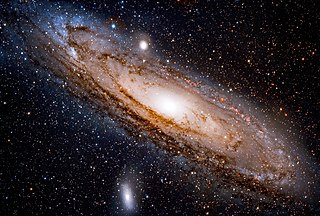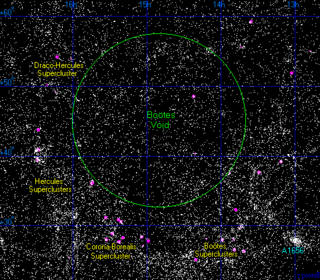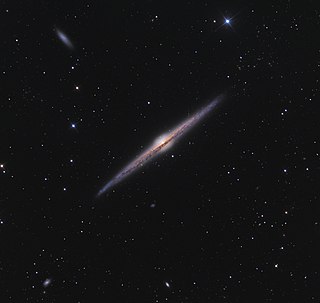
A galaxy is a gravitationally bound system of stars, stellar remnants, interstellar gas, dust, and dark matter. The word galaxy is derived from the Greek galaxias (γαλαξίας), literally "milky", a reference to the Milky Way. Galaxies range in size from dwarfs with just a few hundred million stars to giants with one hundred trillion stars, each orbiting its galaxy's center of mass.

Star clusters are large groups of stars. Two main types of star clusters can be distinguished: globular clusters are tight groups of hundreds to millions of old stars which are gravitationally bound, while open clusters are more loosely clustered groups of stars, generally containing fewer than a few hundred members, and are often very young. Open clusters become disrupted over time by the gravitational influence of giant molecular clouds as they move through the galaxy, but cluster members will continue to move in broadly the same direction through space even though they are no longer gravitationally bound; they are then known as a stellar association, sometimes also referred to as a moving group.

The Andromeda Galaxy, also known as Messier 31, M31, or NGC 224 and originally the Andromeda Nebula, is a barred spiral galaxy approximately 2.5 million light-years from Earth and the nearest major galaxy to the Milky Way. The galaxy's name stems from the area of Earth's sky in which it appears, the constellation of Andromeda, which itself is named after the Ethiopian princess who was the wife of Perseus in Greek mythology.

Andromeda is one of the 48 constellations listed by the 2nd-century Greco-Roman astronomer Ptolemy, and one of the 88 modern constellations. Located north of the celestial equator, it is named for Andromeda, daughter of Cassiopeia, in the Greek myth, who was chained to a rock to be eaten by the sea monster Cetus. Andromeda is most prominent during autumn evenings in the Northern Hemisphere, along with several other constellations named for characters in the Perseus myth. Because of its northern declination, Andromeda is visible only north of 40° south latitude; for observers farther south, it lies below the horizon. It is one of the largest constellations, with an area of 722 square degrees. This is over 1,400 times the size of the full moon, 55% of the size of the largest constellation, Hydra, and over 10 times the size of the smallest constellation, Crux.

The Triangulum Galaxy is a spiral galaxy 2.73 million light-years (ly) from Earth in the constellation Triangulum. It is catalogued as Messier 33 or NGC 598. The Triangulum Galaxy is the third-largest member of the Local Group of galaxies, behind the Andromeda Galaxy and the Milky Way. It is one of the most distant permanent objects that can be viewed with the naked eye.
The Digitized Sky Survey (DSS) is a digitized version of several photographic astronomical surveys of the night sky, produced by the Space Telescope Science Institute between 1983 and 2006.

The Boötes void is an enormous, approximately spherical region of space, containing very few galaxies. It is located in the vicinity of the constellation Boötes, hence its name. Its center is located at approximately right ascension 14h 50m and declination 46°.

The following outline is provided as an overview of and topical guide to astronomy:
Andromeda X is a dwarf spheroidal galaxy about 2.9 million light-years away from the Sun in the constellation Andromeda. Discovered in 2005, And X is a satellite galaxy of the Andromeda Galaxy (M31).

NGC 4565 is an edge-on spiral galaxy about 30 to 50 million light-years away in the constellation Coma Berenices. It lies close to the North Galactic Pole and has a visual magnitude of approximately 10. It is known as the Needle Galaxy for its narrow profile. First recorded in 1785 by William Herschel, it is a prominent example of an edge-on spiral galaxy.

The Andromeda–Milky Way collision is a galactic collision predicted to occur in about 4.5 billion years between the two largest galaxies in the Local Group—the Milky Way and the Andromeda Galaxy. The stars involved are sufficiently far apart that it is improbable that any of them will individually collide. Some stars will be ejected from the resulting galaxy, nicknamed Milkomeda or Milkdromeda.

NGC 27 is a spiral galaxy located in the constellation Andromeda. It was discovered on 3 August 1884 by Lewis Swift. It forms a galaxy pair with the nearby UGC 95.
Two instruments known as the Submillimetre Common-User Bolometer Array, or SCUBA, have been used for detecting submillimetre radiation on the James Clerk Maxwell Telescope in Hawaii.

An astronomical catalog or catalogue is a list or tabulation of astronomical objects, typically grouped together because they share a common type, morphology, origin, means of detection, or method of discovery. The oldest and largest are star catalogues. Hundreds have been published, including general ones and special ones for such items as infrared stars, variable stars, giant stars, multiple star systems, star clusters, and so forth.
Andromeda XXI is a moderately bright dwarf spheroidal galaxy about 859 ± 51 kiloparsecs (2.80 ± 0.17 Mly) away from the Sun in the constellation Andromeda. It is the fourth largest Local Group dwarf spheroidal galaxy.
Andromeda XXII is a low surface brightness dwarf spheroidal galaxy about 940–1,033 kiloparsecs away from the Sun in the constellation Pisces, of the Local Group.
Andromeda XIX is a satellite galaxy of the Andromeda Galaxy (M31), a member of the Local Group, like the Milky Way Galaxy. Andromeda XIX is considered "the most extended dwarf galaxy known in the Local Group", and has been shown to have a half-light radius of 1.7 kiloparsec (kpc). It was discovered by the Canada–France–Hawaii Telescope, and is thought to be a dwarf galaxy.

Donatiello I, also known as Mirach's Goblin, is a dwarf spheroidal galaxy in the constellation Andromeda, located between 8.1 and 11.4 million light-years from Earth. It is a possible satellite galaxy of the dwarf lenticular galaxy NGC 404, "Mirach's Ghost", which is situated 60 arcminutes away. It is otherwise one of the most isolated dwarf spheroidal galaxies known, being separated from NGC 404 by around 211,000 light-years. The galaxy is named after its discoverer, amateur astrophotographer Giuseppe Donatiello, who sighted the galaxy in a 2016 review of his archival long exposures from 2010 and 2013. Follow-up observations with the Roque de los Muchachos Observatory led to a scientific paper on its discovery being published in December 2018.

NGC 999 is an intermediate spiral galaxy located in the constellation Andromeda about 195 million light-years from the Milky Way. It was discovered by the French astronomer Edouard Stephan in 1871.












